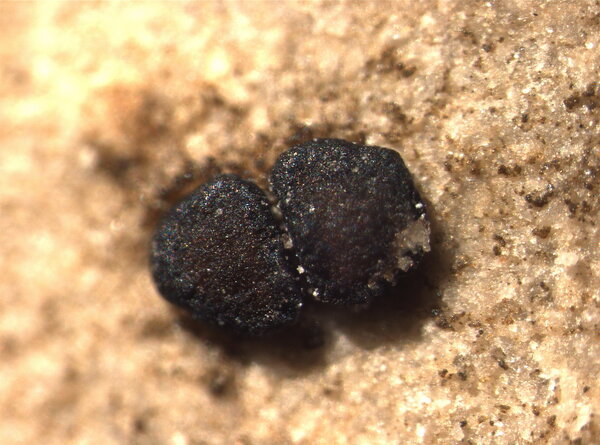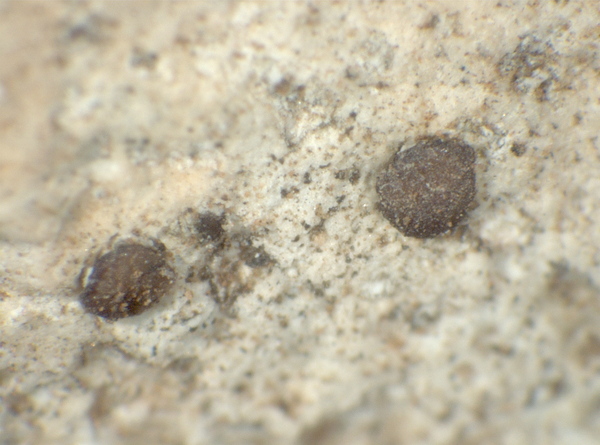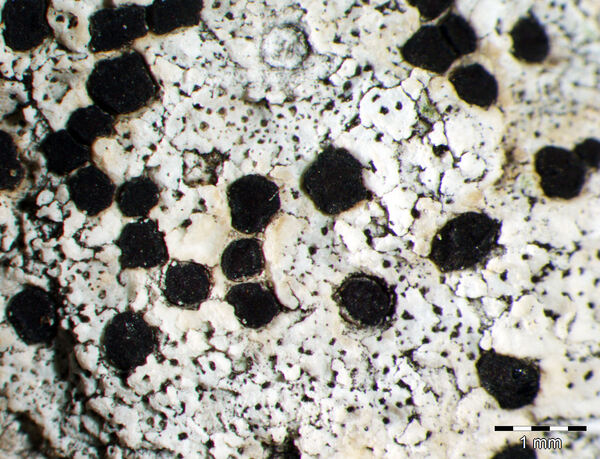Clauzadea metzleri (Körb.) D. Hawksw.
Clauzade & Cl. Roux ex D. Hawksw. in Coppins & al., Lichenologist, 24: 367, 1992. Basionym: Biatora metzleri Körb. - Parerga Lichenol.: 162, 1860.
Synonyms: Lecidea metzleri (Körb.) Th. Fr.; Lecidea oolithina Nyl.; Protoblastenia metzleri (Körb.) J. Steiner
Distribution: N - VG, Frl (TSB 6402), Ven (Nascimbene & Caniglia 2003c), TAA (Meyer 2002), Lomb, Emil (Nimis & al. 1996, Fariselli & al. 2020), Lig (Meyer 2002, Giordani & al. 2016). C - Tosc (TSB 38214), Marc (Nimis & Tretiach 1999), Umb (Genovesi & Ravera 2001, Ravera & al. 2006), Laz, Abr (Nimis & Tretiach 1999, Meyer 2002, Gheza & al. 2021), Mol (Nimis & Tretiach, 1999, 2004, Caporale & al. 2008), Sar. S - Camp (Aprile & al. 2003, 2003b, Nimis & Tretiach 2004), Pugl (Nimis & Tretiach 1999, Meyer 2002), Bas (Nimis & Tretiach 1999), Cal (Puntillo 1996), Si (Nimis & al. 1994, Grillo & Caniglia 2004, Caniglia & Grillo 2005, 2006).
Description: Thallus crustose, endosubstratic or rarely thinly episubstratic, < 1 mm thick, white, pale grey or pale ochre-coloured, usually poorly evident, and weakly structured. Apothecia lecideine, 0.3-0.8(-1.2) mm across, half to three quarters immersed in shallow pits in the rock, with a black (purple black when wet), epruinose, flat to slightly convex disc, and a thin, black (also when wet), slightly raised, usually persistent proper margin. Proper exciple thin, poorly developed, reddish brown in outer part, colourless to rarely pale brown within, of radially arranged hyphae, 20-85 µm thick laterally, 10-30 µm thick at base; epithecium ochre-brown to red-brown; hymenium colourless, 90-150 µm high, I+ reddish and partly pale blue; paraphyses sparingly branched and anastomosing, septate but not moniliform, 4-6 µm thick at mid-level, scarcely or not swollen at apex; hypothecium colourless to pale ochraceous brown, broadly plug-like, I-. Asci 8-spored, cylindrical-clavate, with a K/I+ blue outer layer and apical dome, and a central, K/I+ darker blue tube, Porpidia-type. Ascospores 1-celled, hyaline, ellipsoid to pear-shaped, (15-)16-23(-28) x 6-10(-12) µm, often guttulate, with a 0.7-1.5(-2.4) µm thick, gelatinous perispore when young, the wall of old spores not warted. Pycnidia black, laminal, isolated or clustered, partially immersed. Conidia bacilliform 4-5 x 1-1.5 µm, with apical and lateral conidiogenesis. Photobiont chlorococcoid. Spot tests: thallus K-, C-, KC-, P-, UV-. Chemistry: without lichen substances.Note: a mainly temperate, holarctic early coloniser of small calcareous pebbles in dry grasslands, widespread and locally common throughout Italy, especially below the montane belt.
Growth form: Crustose
Substrata: rocks
Photobiont: green algae other than Trentepohlia
Reproductive strategy: mainly sexual
Pioneer species
Commonnes-rarity: (info)
Alpine belt: absent
Subalpine belt: absent
Oromediterranean belt: rather rare
Montane belt: rather common
Submediterranean belt: common
Padanian area: very rare
Humid submediterranean belt: common
Humid mediterranean belt: rather common
Dry mediterranean belt: rather rare

Predictive model
Herbarium samples
Growth form: Crustose
Substrata: rocks
Photobiont: green algae other than Trentepohlia
Reproductive strategy: mainly sexual
Pioneer species
Commonnes-rarity: (info)
Alpine belt: absent
Subalpine belt: absent
Oromediterranean belt: rather rare
Montane belt: rather common
Submediterranean belt: common
Padanian area: very rare
Humid submediterranean belt: common
Humid mediterranean belt: rather common
Dry mediterranean belt: rather rare

Predictive model
| Herbarium samples |
 Index Fungorum
Index Fungorum
 GBIF
GBIF





